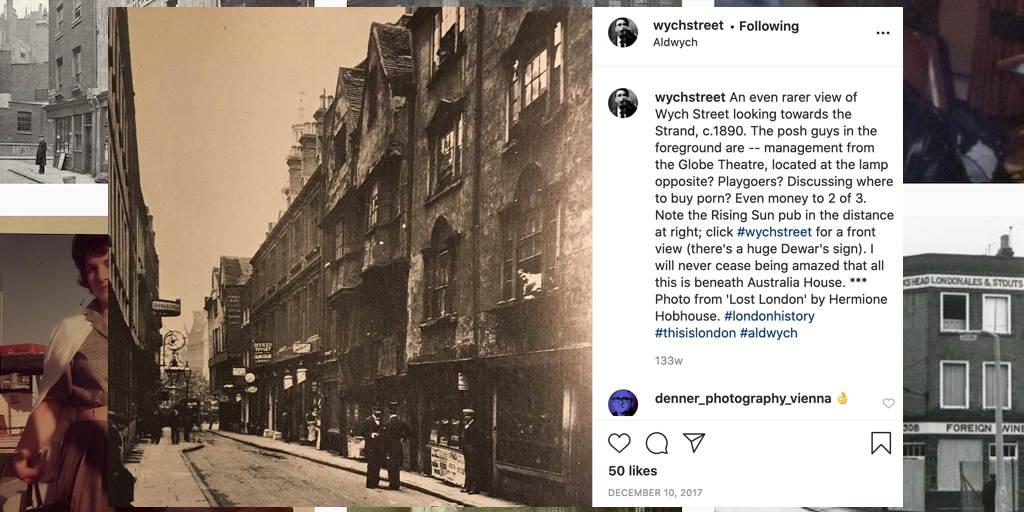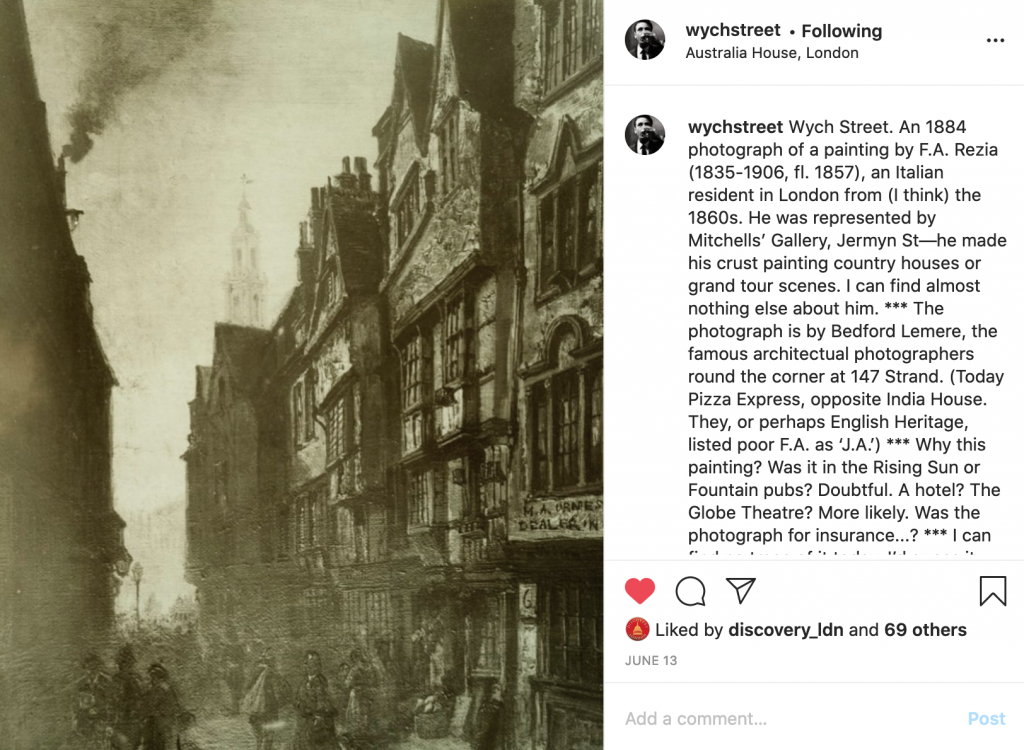#MyStrand: Justin Sherin, playwright and screenwriter
Posted in 19th Century, 2020-2029, 20th Century, 21st Century, contemporary, future, people, Places, shops, Stories, Strandlines, streets and roads, theatres and tagged with digital life writing, Explore London, instagram, Interview, life writing, London by Londoners, MyStrand, People of the Strand, Photography, Visual history

I often scour Instagram for gorgeous, strange, or mysterious looking photographs of the Strand, historical and contemporary.
@WychStreet, an account run by Justin Sherin, is an account I return to again and again, as the photographs – and generous evocative captions – instantly transport me into the past.
Justin was kind enough to share some of his stories with Strandlines for this post. From a fleeting childhood memory to a ghost story, our conversation is an excellent taster of what you can find over on his instagram page.
Thank you so much, Justin.
Fran – Assistant Editor, Strandlines
Your posts of beautiful old photographs caught our eye on Instagram. Can you briefly introduce yourself to our readers: who are you, and why do you share old photos of the Strand area?
I’m a playwright and screenwriter. I grew up near Philadelphia, first home of Craven St.’s most famous resident, Benjamin Franklin.
I came to London with my Dad in 1995. We were in Maiden Lane doing God knows what — when I turned and saw Bull Inn Court. It looked just as it does now, of course. We didn’t have time to turn in, but I was gobsmacked. That’s the only word. A weird, strong, inexplicable gravitational pull — ‘this makes sense.’
When I returned to work in the theatre in 2002, Bull Inn Court was one of my first stops. (I quickly found the Nell Gwynne’s jukebox.) Luckily I’ve been back and forth a lot since. Though not so much lately. I miss it.
How did you start collecting London photos?
London is beautiful because you can see all 2000 years in a street if you look hard enough. I’ve always wanted to figure out how old London fits into the one I know.
Often it sneaks in. In the City, Cullum St. looks nothing like 1910—but there’s a barbershop nearly on the footprint of one from back then.
When screamingly poor I used to walk the streets all day. It got in my blood. I found out about the Oxford Arms, Warwick Lane, one of the last coaching inns, and went to the Guildhall to buy a print of a ghostly man standing at the entrance. I had to eat more cereal for a few weeks, but it was worth it. When I hung it in my little room I felt less lonely.
Now the archives are online it’s a good way to daydream and avoid writing. The Bishopsgate Institute is especially good. Charles Goss (1864-1946) created their London collection. He was an obsessive. He took lots of photographs himself, and saved everything down to handbills and merchant tokens. Archivist Stefan Dickers still runs the Bishopsgate in that spirit.
Why did you choose the name @WychStreet for your Instagram account?
I think Wych St. and Holywell St. symbolise what London is vs. what some try to make it.
You could get drunk there, go to the theatre, find a man or woman, buy a cheap bed for the night, and take home ‘literature’ to lock in your desk. The houses were in rough shape. No wonder the Victorians tore it down.
But people went there for a good time, or to kill time, or just to get by. They were for everybody, so they were beautiful in a way the Aldwych isn’t.
London has always torn down and rebuilt, but London is for Londoners. We can’t forget that.
What’s the biggest difference in the Strand area in the last 10 years? What about 100 years?
For the Victorians it was London’s high street. But today you come for the theatre, or Somerset House, and mostly drink or shop or get haircuts elsewhere. It’s a shame. That’s grown in my lifetime.
I tend to linger in the area around Villiers St./Charing Cross because there’s a rush. People are there to do things, not just go to the office. Gordon’s Wine Bar is a great crossroads of humanity.

“Wych Street. An 1884 photograph of a painting by F.A. Rezia (1835-1906, fl. 1857), an Italian resident in London” – Shared by @WychStreet 13 June 2020.
Which photos are most popular with your followers? Why do you think that is?
People like when I discuss Wych St. and Holywell St. because they’re almost palpable, I think. A wound at the heart of things. Nobody likes the Aldwych, they’re not sure why—so when you reveal a warren of theatres and porn and brothels and pubs and actors’ digs and esoteric shops under Australia House, they’re fascinated.
I try to post photos that show the past is nearer than we think, or else places that are long forgotten. When you see New Inn, for example—a strange, shabby little place—265 Strand (its site today) never looks the same again.
Can you tell us about your personal favourite photos or stories?
I may have seen the ghost of William Terriss. (Actor-Manager at the Adelphi, murdered by a deranged employee at the stage door in 1897. I have it on good authority he still runs the place.)
Years ago I wandered up Bull Inn Court in a snowy twilight to take a photo. I stood in line with the Adelphi stage door. Went home, thought nothing of it, then blew it up and showed it to a friend: ‘Who’s that?’
We saw a guy in a top hat, somewhat transparent, about six feet ahead.
Nearly everyone responded the same way, unprompted. Sadly it was the early days of digital cameras, and the photo is now with Terriss, up in the air somewhere … he was known to help young people make their way in the theatre, so maybe he nodded to me.
As for my posts, I enjoy putting people and places together—perhaps resurrect them both a little. Such as Mr Elgrod, Ebenezer Newby, or this guy (below) in Wych St.
What can people expect to see if they follow @wychstreet on Instagram?
Occasional London time travel with detours to New York. Also dogs and cats.

Photo of Wych Street, 21st June 1901, shared by @WychStreet on instagram, 12 January 2020.


Well I hate to be the harbinger of dissent, but the major assertions concerning physical locations comparing past to present in the top and bottom photographs are incorrect.
The Globe Theatre fronted on to Newcastle Street, which ran from the old, unwidened Strand immediately behind the church of St. Mary’s up past both Holywell and Wych Streets, terminating at Houghton Street, the latter of which, like the church, remains in situ. These usefully fixed points – neither construction has moved much in centuries – allow the exact course and scale of Newcastle Street to be fairly easily reconstructed on the modern ground-plan; and since it formed the western terminus of both the other streets, and the dimensions of both the Globe and Opera Comique theatres that occupied largely subterranean space between Holywell and Wych Streets are known, it’s relatively simple to stand today at the rear of St. Mary-le-Strand and discover that the route of Newcastle St. is more-or-less exactly delineated by the twin sets of gates that block off the intervening courtyard of what was up until recently the BBC’s Bush House, one set fronting on to the Strand, the other on to the Aldwych circle with a clear line of sight through to Houghton St. on the other side of the road.
What then immediately becomes clear is that neither theatre – back-to-back as they were, sharing a party wall at their stage rears – is under what is now Australia House, which is somewhat further to the east. They are, or were, on the spot of what is now just open internal courtyard, plain and pavemented, and perfectly visible from the gates though not open to the general public, alas.
Also, in the top photograph, we learn that “the Globe Theatre…..located at the lamp opposite”. Except it wasn’t. The photo is indeed, as asserted, looking east (as is verified by the summit of the spire of St. Clement Danes just visible above the rooftops): in which case the theatre(s) weren’t in front of the photographer and to his left, but rather behind him and on his right, as cursory examination of any map of the period showing both theatres and their spatial relationship to the church will easily confirm. I suspect, but have no evidence, that Mr. Sherin has been subconsciously misled by the sign just above the lamp marked “SHAKESPEARE”. But this isn’t Shakespeare’s Globe – which in any case was on the other side of the river – it’s The Shakespeare’s Head public house, which occupied No.31 Wych St. and sold Worthington Pale Ales (I have a number of photos of the place in my collection taken front-on).
I may add that a THIRD theatre – the Olympic, much bigger and altogether grander than the other two – is now largely buried under the main entrance block of Bush House, the remainder underneath the (very wide) pavement in front of it. And though I’ve both been told and read in print that there is a piece of wall somewhere inside Bush House bearing the legend “Olympic Theatre”, neither I nor my partner, a former senior World Service producer for the BBC who worked in the building for many years, were ever able to find any trace of it. Given that the Olympic was on the western side of Newcastle Street, and north of Wych St. (whilst the Globe and Opera Comique – home incidentally of four Gilbert and Sullivan premieres – were on the east of the former and south of the latter) and sits under Bush House, I’m afraid that the “rickety twins” are certainly underneath nothing more imposing than pavement.
There is also the matter of the bowler-hatted boy in the bottom photo – a much enlarged detail from a comprehensive street-long panorama – whom we are told is standing at “about the spot of today’s 265 Strand, just before the bus stop at Aldwych”. Wych St. was nowhere near the northern side of the Aldwych Circle roadway, which is where 265 is: it was wholly subsumed within Bush House’s courtyard. Also, again, the larger photo is east-facing, which means that the boy is standing on the south side of Wych St. no more than some 45 feet from the Strand itself – the intervening Holywell St was notoriously narrow, as were its ancient Elizabethan buildings – whereas the modern 265 is some 120 feet further north, occupying what was the middle courtyard of New Inn until its demolition in the 1890s.
Sorry to go in to quite so much detail. But the whole Aldwych/Kingsway project is a particular passion of mine too, and as a former academic it rather disturbs me to see so much inaccuracy pass unremarked.
Hello Stephen,
Thank you so much for sharing so much detail! This is some super photo detective work.
If you ever have other stories and knowledge of your own to share we are always open to contributions.
Thank you!
Fran – assistant editor.